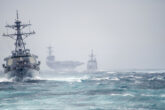October 25, 2018
Exiting the Russia nuclear treaty impacts military strategy in Asia
President Trump recently announced that the United States will soon exit the Intermediate Range Nuclear Forces Treaty with Russia. This will open significant options for the United States to adjust its military posture in the Asia Pacific. While we do not take a position on whether the United States should ultimately exit from the treaty, we do believe that it is reasonable to reassess whether it continues to be in our interests to abide by its restrictions when the other party does not and while the global distribution of military power grows increasingly multipolar.
For more than a decade, China has made significant investments in conventional ground based intermediate range missiles, primarily because Beijing believes that is surest way to cripple the ability of the United States to project power into East Asia. As Harry Harris, the former head of the Pacific Command and current ambassador to South Korea, told the House Armed Services Committee earlier this year, more than 90 percent of the ground based missiles China has would violate the treaty.
As Beijing well knows, geography has forced the United States to rely solely on expensive air and sea platforms that are limited in the number of munitions they can carry to project power into East Asia. Leaving the treaty would allow the United States to project power more efficiently. A conventionally armed intermediate range cruise or ballistic missile battalion could be rapidly moved by air or sea to any location a wheeled vehicle can access, opening up endless possibilities across the region and even in Alaska. It would also free our high demand pilots and sailors to prioritize other missions better suited to air and naval power.
Additionally, these systems would complicate Chinese military planning and enhance deterrence by presenting an offensive capability that can be rapidly deployed across East Asia. The Chinese military would be forced to constantly worry about potential deployment of these systems. Instead of American strike capabilities being relegated to increasingly vulnerable air and naval platforms and well known bases, strikes could originate from unpredictable locations on unsinkable islands. This is exactly the sort of competitive strategy United States planners would be eager to exploit.
Read the full article in The Hill.
More from CNAS
-
How Trump Will Change the World
Trump has won the chance to determine U.S. national security policy and will wield the impressive power embodied in the men and women now waiting to work for him....
By Peter Feaver
-
More than the Sum of its Parts: Developing a Coordinated U.S.-Australian Response to Potential Chinese Aggression
If China engaged in a war of aggression, the United States, Australia, and other nations would not have much time to develop a coordinated response....
By Stacie Pettyjohn
-
To Focus on China, U.S. Needs to Wean off Europe and Middle East Missions
If the United States cannot rebalance its military focus toward the Indo-Pacific it risks expediting Chinese aggression in the region and furthering the decline of the US-led ...
By Carlton Haelig
-
The Evolution of Drones with Stacie Pettyjohn, Center for a New American Security
Stacie Pettyjohn, Senior Fellow and Director of the Defense Program at the Center for a New American Security, joins Squaring the Circle to discuss the evolution of drones. ...
By Stacie Pettyjohn




